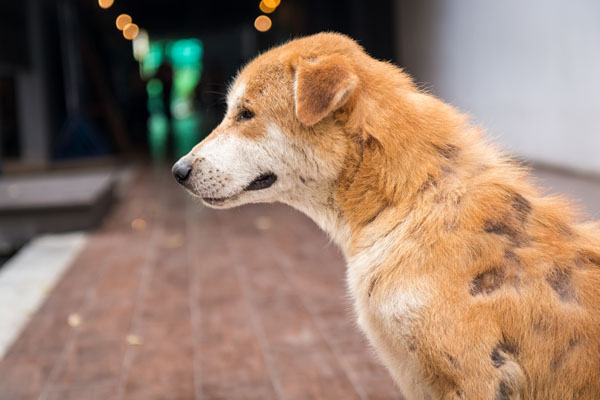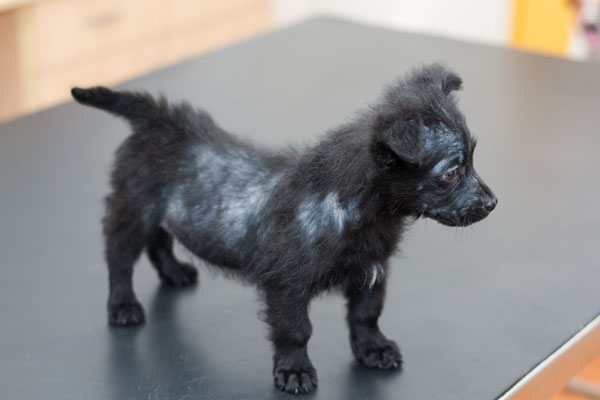Seasonal changes bring common sights with them. Spring means fresh flowers. Summer brings trips to the beach. Fall always heralds changing leaf color (and pumpkin spice everything). Winter prompts thoughts of ice and snow. But for pet owners, there’s an additional sight the changing seasons bring along: shedding hair. Whether you have a short-haired or long-haired dog, you know you’ll need to break out your brush with each shift of the sun. And while a clump of shed hair feels satisfying at the end of a grooming session, you have your limits. You DON’T expect to see bald spots on your furry friend. But what does a dog losing hair mean? Is it something you did? And when do you need to get worried? Let’s examine those thinning hair patches a little closer.
Alopecia
Any time you see spots of abnormal hair loss, your dog’s experiencing alopecia. And while there’s a single term for a dog losing hair, there are PLENTY of causes for the condition. Alopecia pops up in any breed, at any age (yup, puppies, too!), and it can happen at any place on the body. There’s a general form of alopecia (which is what most owners see), but you’ll also find specific types:
- Alopecia areata: You don’t see this autoimmune disease very often. It causes local spots of hair loss around the head and neck.
- Follicular dysplasia: Does your dog’s hair loss make them look moth-eaten? This genetic alopecia is coded in certain breeds.
- Pattern baldness: No, not male pattern baldness. Instead, dogs develop hyperpigmentation under the spots where hair loss occurs. And no one’s quite sure why.
- Pinnal alopecia: You see bald spots appear on the pinna or ear flaps as the hair grows smaller and smaller.
- Post-clipping alopecia: Following grooming or surgical procedures, your dog’s hair CAN fail to grow back. No one knows why, either.
- Post-injection alopecia: Certain injections (usually the Rabies vaccine and steroids) create so much inflammation, you end up with dog hair loss around the site where the needle went in.
- Traction alopecia: People love using barrettes in their dog’s hair. But the cute little bows pull HARD on hair follicles. And the strain causes them to let go.
Recognizing Alopecia
Most dogs, though? They don’t fall into those special cases. And you’re going to notice your dog’s coat getting thinner (or disappearing altogether). But you need to make sure you’re not missing other important signs. So while seeing those bald patches gets scary enough, you want to pay attention to other clues to start to piece together what’s really going on:
- Where the hair loss occurs
- Looking to see if the bald patches are symmetrical
- If you can detect an odor
- Any itchiness
- Whether you see dark grey or black skin on the skin underneath
- If there’s red skin under or around the bald spot
- If you see any bleeding
Having this information can help your veterinarian with a diagnosis. And while some of those questions sound a little crazy (I know you’re dying to know why symmetry is important), they help check off boxes when it comes time to puzzle out why a dog is losing hair.

Dog Losing Hair
You have a dog losing hair. And you performed a thorough check, taking notes of all of those possible extra symptoms. Hopefully, you’ve also made an appointment with your vet so you can get to the bottom of why you’re finding yourself with a new hairless breed of dog. But you’d still like to know what could be causing all of those beautiful clumps of hair to fall out. It can’t be THAT long of a list, right?
Actually, it’s pretty impressive. You have everything from hormonal changes to parasites to injuries. And some of those answers? They’re easier to figure out than others.
Allergies and a Dog Losing Hair
The biggest culprit for a dog losing hair? Allergies. And the biggest reason for that allergic reaction? Not food or even the dreaded pollen that sends most humans fleeing indoors. Nope, it’s FLEAS! Flea bites send most dogs over the edge, causing them to lick and bite at their coat, pulling out hair. And it’s usually around their tail. Before you know it, you have a dog with a naked butt. And it only takes ONE flea to lead to alopecia!
Hair loss from allergies usually comes with red irritation. And, of course, you’ll see plenty of itching happening. You’ll want to get the proper antihistamine to soothe your poor pup in the first place, but then it’s a good idea to get allergy testing performed. And if there’s a suspect of fleas? You need to make sure you’re on top of your preventative. It’s a good idea to apply your treatments year-round. With warmer temperatures prevailing, fleas and ticks aren’t dying during the winter. And that means you could see a dog losing hair in the middle of January.
Hormonal Reasons For a Dog Losing Hair
Hormones are important for every aspect of your dog’s life. And when they decide to get out of whack? You can start to see crazy things happen with their hair. Sometimes it’s something easy. For instance, pregnancy often results in hair loss while the mother carries the puppies, all the way until they’re weaned. But once her body’s hormones return to normal? You’ll see her hair grow back in.
Other times, hormones aren’t as easy. Getting them under control requires veterinary intervention. And if you DON’T make that appointment, you won’t see your dog’s hair return to normal. The two biggest culprits? The adrenal glands and the thyroid.
Cushing’s Disease
Hyperadrenocorticism or Cushing’s disease results when the adrenal gland produces too much cortisol. Cortisol is a natural steroid in the body. And when there’s too much, you can see a dog losing hair. You’ll also see an increased appetite, thirst, urination, and panting. Not to mention a very distinctive pot-bellied appearance.
Your vet can test for Cushing’s with a blood test. And once they have confirmation? They’ll start your pup on medication to calm that adrenal gland down. The good news is that, once their system gets under control, you’ll see their hair growth return to normal. (And, of course, those other symptoms return to baseline, too)
Hypothyroidism
Hypothyroidism is exactly what it sounds like: the thyroid gland doesn’t produce enough thyroxine hormone. And since the thyroid participates in pretty much all aspects of the body, you’ll see signs from nose to tail. They act cold ALL the time (even if you pile on blankets or dress them in sweaters). They shed CONSTANTLY, to the point you’ll see hair loss. But here’s the kicker – it’s SYMMETRICAL. (See? I told you it’d be important) They gain weight, even if you attempt to monitor their diet.
Once again, a quick blood test will give you the answer. And the treatment is a daily synthetic version of the thyroid hormone. Within no time, your dog will return to normal. And their hair? It comes back in – beautiful and soft as you could ask. Our Greyhound is hypothyroid. And you could draw a line down the center of her body and match up the bald patches when we adopted her. But now? You’d never know (if you skip over her thighs – which we’ll get to in a minute).
Parasites and a Dog Losing Hair
A poor dog battling fleas is troubling enough. But other ectoparasites (parasites that live outside the body) can lead to a dog losing hair. And some of them have the potential to jump to YOU. That makes it doubly important for you to get a quick diagnosis as soon as you see funny bald patterns appearing on your furry friend.
These particular pests? They WON’T go away on their own. You’ll need to get treatment from your vet. And if you have other pets in the house, you may need to keep an eye on them for emerging patches of hair loss. (That goes for cats, too, by the way)

Mange
Most people are familiar with the concept of mange. But there are two forms of this mite-caused skin condition: demodectic and sarcoptic. And it DOES matter which your dog has when their hair starts falling out.
Demodectic mange is fairly common, especially in young or sick dogs. The Demodex mite lives on skin normally. (Yes, it’s on YOUR skin right now) It doesn’t result in a dog losing hair until the mites grow out of control. And that usually only happens when the canine in question has a suppressed immune system. While it’s not pleasant to see these pups, you only need to return them to normal health. The hair loss will stop, and most of the hair will grow back in. (If they have severe thickening of the skin resulting from the infestation, it may not)
Sarcoptic mange? That’s different. This is also known as Scabies, and it’s zoonotic. If you look at the two mites, they look nothing alike. But you need a microscope for that. From the outside? The bald patches are pretty much identical. And sarcoptic mange can go after a dog (or human) that’s perfectly healthy.
Ringworm
Ringworm is a little misleading. It’s a fungus, not a worm. And it IS a nuisance to every animal it encounters. You can easily recognize ringworm infections by the circular patterns of hair loss. They usually look red, and (if they’re particularly nasty) they form crusts on the bared skin. Oh, and if you have a blacklight lying around? The lesions will glow.
Sometimes, ringworm goes away on its own. Of course, while you’re watching your dog losing hair, that fungus is waiting to jump to everyone else in the house. So you’re much better off getting your pup started on treatment to eliminate the pest. Most of the time, a few quick baths with medicated shampoo will do the trick. Other times? (Say, when the nasty pest is REALLY embedded?) You’ll need to move up to oral antifungal treatment.
Other Reasons For a Dog Losing Hair
Sometimes, you won’t find a medical reason why your dog is losing hair. At least, not the medical reasons most people think of. For instance, there ARE breeds out there that start to develop bald spots as they age. After that first year (when they’re cute and fuzzy), hair starts to fall out of their ears, chest, belly, thighs, and lower neck. And there’s nothing you can do, unhappily. It’s a normal part of these breeds:
- Chihuahuas
- Dachshunds
- Greyhounds (Which is why our girl has a naked back end)
- Italian Greyhounds
- Whippets
Other times, a dog losing hair can signal pressure sores. If your dog regularly sleeps on a hard surface, the parts of their body feeling the most pressure will form thicker skin. Those calluses will result in hair loss. You can easily prevent this by providing cushy beds. Even an elevated bed will help alleviate the pressure on their joints.
Diagnosing a Dog Losing Hair
When you bring your poor dog to the vet for losing hair, expect your vet to request some basic testing. What they’re doing is working through the above possibilities. Your notes will help them narrow down what they need to focus on rather than running through the entire list. (Well, unless you have one of those genetic breeds) Each recommendation DOES serve a purpose, though:
- Physical exam: Remember the pattern you checked for? The vet’s looking for the same thing. Hormone problems present with symmetrical hair loss. Patches near the tail usually mean a flea allergy. Hair loss on the feet? That’s usually environmental allergies.
- Lab work: If your dog has a hormone issue, this is where it will turn up.
- Skin impression: Pressing a glass slide onto the bare skin will collect bacteria, fungus, yeast, and other cells they can examine under the microscope.
- Skin scraping: For mange, they need to go deeper into the hair follicles. So they use a sterile blade to gently scrape cells.
- Luminescence: Remember the blacklight trick? Yup, vets do it, too.
- Allergy testing: If your vet DOES think your dog has allergies, this will pin them down.
- Biopsy: When other tests don’t have answers, or if the hair loss continues, they may do a skin biopsy to check for deeper concerns.
Preventing the Worst Hair Loss
It’d be nice to say you can prevent every kind of dog alopecia. But too many possibilities exist out there which are beyond everyone’s control. You don’t want to see your dog losing hair, though. So what can you do? CAN you do anything to stop bald spots from appearing on your pup’s gorgeous fluffy coat?
Of course!
First and foremost, make sure you use a veterinarian-recommended flea and tick preventative ALL year. This will prevent any possible problems with those little biting arachnids. (And it’s MUCH easier to stop fleas from becoming a problem than it is to cope with them after they’ve invaded) If you go hiking with your dog, perform a thorough tick check as soon as you get back to the car. This way, you won’t give them a chance to latch on and test the effectiveness of your preventative.
Use a moisturizing shampoo when you bathe your dog. And make sure you DON’T schedule baths too frequently. Dry skin can lead to irritation and dryness, which will prompt itching. The more your dog itches, the more hair they’re going to kick out in the process. At the same time, keep your dog hydrated by providing fresh, clean water at all times.
You can also give their skin a boost with their diet. High-quality foods rich in omega-3 fatty acids will help support their skin naturally – and their immune system, too. Or you can add fish oils to your dog’s diet as a supplement to get the same effect. Either way, you’ll improve the look and feel of their coat. And brushing them regularly? That’ll put the cherry on top.
Doggie Pattern Baldness?
A dog losing hair is ALWAYS a cause for concern. But pinning down the reason isn’t easy – especially if you skip that trip to the vet. There are too many medical causes for why a dog can develop alopecia. And they require treatment from a licensed veterinarian. Not to mention some of those parasites? They’ll happily cross over to YOU. As soon as you see clumps of fur coming off your dog, make that appointment.
Besides, unless you HAVE a hairless dog, odds are you don’t want your poor baby to end up that way. (I mean, of course, you’ll love them if it comes to that, but it’s probably not a goal)













No comment yet, add your voice below!